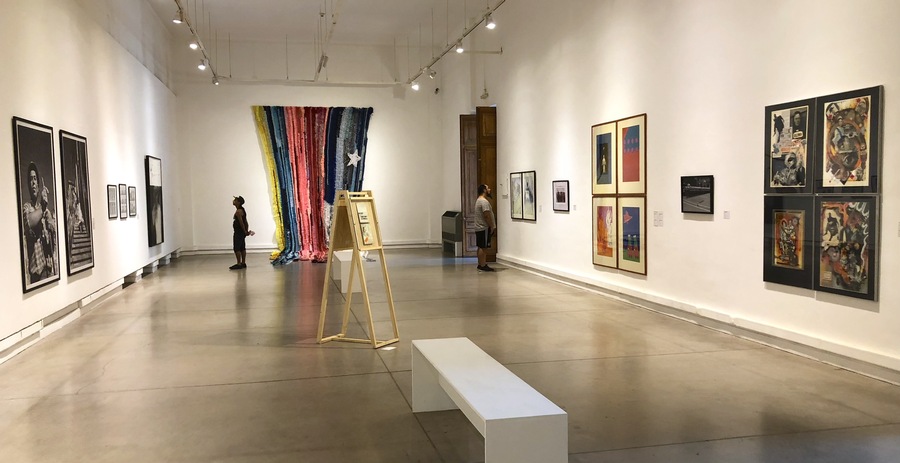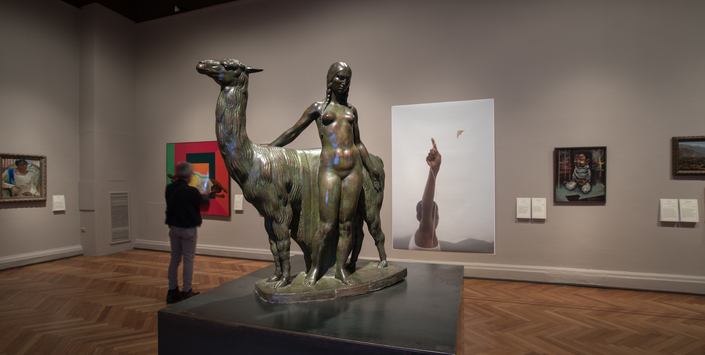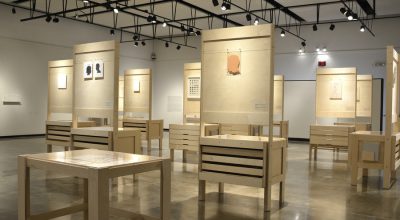
PERMANENT VS. TEMPORARY EXHIBITIONS IN CHILE
In Germany, my home country, we are extremely lucky to have a dense net of cultural spaces, including some of the oldest museums in Europe. My “home” museum is the Alte Pinakothek in Munich, where I could walk the route to Albrecht Dürer’s Self-Portrait with Fur-Trimmed Robe blindfolded. When I am in the area and if I only have fifteen minutes or so, I would enter the Pinakothek to see the masterpiece.
For four years now I have been studying Chilean art and photography, and have made several extended trips to Santiago and the regional capitals Valparaíso and Concepción. My goal being to get to know as many spaces and artworks as possible to learn comprehensively about local art history and contemporary production. As a visitor, my impression is that Santiago has a vivid art scene that offers me plenty of opportunities to get my art fix. There are a few major institutions with a solid topical program, and a plethora of galleries and offspaces scattered all over the city. Now, understandably, local artists and cultural workers have a different opinion, often being exclusively dependent on that confined infrastructure, which, after time, does grow small, and connections to other art centers like Lima and Buenos Aires are underdeveloped and distances far (compared to European standards). Though as a visitor, I maintain, the agenda is not at all bad.
Yet, what I miss is a fixpoint, a Chilean Pinakothek with Chilean Dürers. The only such place is the Pinacoteca of the Universidad de Concepción, which I visit every time I go to this city. The mural by Jorge González Camarena in the foyer and the room of Chilean painters of the nineteenth century on the second floor are, in my opinion, a fundamental contribution of exhibition practice to Chilean art history. In basically all other institutions, it is unlikely to see the same artworks installed over a longer period of time. Temporary exhibitions and “collections in dialog” account for an artistic landscape in flux. But if history is composed of things that stay (at least in our memory), then all this other art that is exhibited in dense exhibition cycles does not enter history.
Working myself as a curator and researcher, and having many artist friends, the benefits of the temporary exhibition system are evident: there is, simply, more to do. Moreover, it has become a sort of international requisite, with lighthouse mega-institutions like the Museum of Modern Art in New York spending billions of dollars to rethink their curatorial approach to lift genre boundaries so as to provide the possibility of an endlessly reinterpreted collection, and incite conversations through extramural interventions. Still, in Chile, I cannot let the feeling go to wish for a parallel, permanent environment—a rock in the sea of art programming. I would therefore like to present some arguments and offer a reflection on why I think so conservatively. I will first present some pros and cons of temporary and permanent exhibitions, before moving on to questioning but ultimately justifying my plea for more permanent installations. Ultimately, it is a comparison of apples and pears, but maybe necessary in an environment in which one format widely exceeds the other.
With a relatively high number of art schools producing dozens of artists and curators every year in Chile, the country’s art scene needs to find ways to sustain the artistic output and set up spaces of reception. One way is to increase the amount of exhibitions per year, in any space, including formerly very traditional spaces like the National Museum of Fine Arts (MNBA). First, this creates more production opportunities for both artists and curators. Grants and exposure in commercial galleries mean more sources of income, too. In a perfect neoliberal environment, the potential of growth is infinite. Second, there is no such thing as a canon with its hierarchies, myths, and inertia. No gender quota to be undone, no master narratives to be retold. In a conversation with MNBA curator Gloria Cortés, she emphasizes the importance of opening up the interpretation of their collection to a wider community in lieu of an elitist academic circle, and therefore to practice new, contemporary meanings of the museum and its objects. Connected to this, the art scene is also very flexible in picking up current topics of the art world and react within weeks to socio-political events (there is a myriad of examples post-estallido 2019). Third, especially for climate sensitive works, conservation is easier as exposure to light and humidity is short term. Fourth, more exhibitions mean more visitors, as there is always something new to discover, and the temporal limitation makes people actually go so as not to miss the spectacle. Fifth, such exhibitions are easier to travel, since they are not conceived as staying in one place for long anyway. The flux of art can thus be stimulated nationwide. In short: the prolific activity of the Chilean art scene is absolutely amazing and produces inspiring results, considering the ingrained precarity of the cultural sector and the many sacrifices everyone has to make to keep it running.
However, there are obvious downsides of temporary exhibitions, especially since it is the dominant dynamic in Chile. The governmental scheme “Fondart” contributes considerably to an almost all-temporary exhibition practice. Their yearly grant applications make it impossible to fund longer running projects. For institutions that depend on that money, the applications and administration of grants consume a lot of resources, every year. Artists, in turn, think in short term projects only, sometimes resulting in an eclectic portfolio without a clear direction. Moreover, institutions, artists, and freelance curators who solely depend on a fast running exhibition cycle are simply overworked. The constant demand for new ideas and works is an intellectual strain that affects even the most prolific and motivated player. It also propagates the ideal of the curator/artist as a Jack-of-all-trades, fluent in all of the hot topics, such as climate change, gender struggle, and digitization, rotating them according to the respective new project cycle. Achieving a qualitatively high and varied program is very difficult for museums with a limited staff count, which is why they invite more extramural projects, which in turn might lead to a weaker institutional profile. One such example is the MNBA, which, as its name suggests, is the highest echelon of national recognition. But with its 12-14 exhibition per year cycle consisting of many outside projects, most of them of contemporary art, the museum is on the verge of becoming a Kunsthalle, or even worse, an event venue.
Back to basics, then, and just leave the art permanently in the galleries? The arguments around such practice that have been alluded to above (the canon, master narratives, expert knowledge) are very much lingering nineteenth century ideals. They stem from the time when royal collections were made public, national galleries founded, countries and societies modernized, and foreign worlds “collected” (i.e. colonized and subjugated to European epistemology). The eurocentric, bourgeois stamp is undeniable: the museum as the apparatus to establish, universalize, and perpetuate particular values, for a selected few. But why do these values appear legitimate to me in 2020, that is, how can they be made productive against the grain?

Although this standard practice has lost its appeal through decades of curatorial adventures propagated by stars like Hans Ulrich Obrist, postcolonial theory, and the commercialization of museums, there are a few advantages. First, permanent exhibitions establish consistency and reliability. These words may be euphemisms for “canon,” but satisfy what I have described in the beginning: the wish to recur to the known, to find some stillness in the whirlwind of the art world. Second, they make possible deeper research on individual objects, as more people over a longer period of time get to see them and connect to them. There is also simply more time to do research, in contrast to works that quickly disappear in artists’ storages or vanish altogether in cases of arte povera style works. Third, the more people see an artwork, the more it can foster a sense of national pride and identity. This is admittedly a controversial argument, since nation building is essentially an exclusive process and pride an equally slippery way of relating to art. In a country conventionally categorized as the periphery and in a global art world based on geoaesthetic principles, however, admitting a space for “Chilean art” has both a strong marketing and epistemic function. That said, while this approach often ends in stereotypization, subsuming all local production as site-unspecific “contemporary” art as a counter-strategy is homogenizing and thus not helping either. Hence, if in doubt, better fare with a double strategy, and in the process provide the means to honestly acknowledge what distinguishes “art from here” (more on this below). Fourth, fixing an exhibition in time, over time, allows us to look back and remember. Since the mid-nineteenth century, much art has been consciously sociopolitically located, and the branch of social art history is based on recalling the conditions an artwork was made under and its contemporaneous meanings. Temporary art exhibitions with short curatorial texts and even shorter media coverage are often unable to leave a lasting trace, even within the same year program.
At the core of these arguments are three notions that express the pragmatic workings of exhibition practice, as well as the potential for epistemic surplus value. These are art history as a value judgment and recognition system, as a discourse of memory, and as a decolonial exercise. The first, the question of quality, harks back at the canon, and therefore invites legitimate criticism as it evokes the most traditional characteristics of the global art world, and in light of commercial excesses, art school debts, and ethical hypocrisy of private museums, appear dubious. I think, however, that some positive aspects can be retained in the following words. Although highly critical of master narratives, James Elkins says about descriptive, relativist art histories: “In the absence of critical judgments, art is bathed in an eerie half-light of uniform praise. (…) In the absence of an author who is partisan to a particular period or style, the reader begins to wonder if anything is better or more interesting than anything else” (Stories of Art, 2002, 77). In our example, if we were to avoid canonization through permanent exhibitions and instead take all temporary exhibitions combined as the history of Chilean art, would it have any importance? Even though it would be a rich and complete panorama, any single temporal exhibition would be as good as a randomly picked other, and thus make each individual one insignificant. Of course, permanent exhibitions are not the only means to confer recognition and write art history, but it is one of the more powerful tools (if we think of all the tourists visiting the MNBA, but do not buy Ivelic and Galaz’s book).
Furthermore, the beneficiaries of such quality management are the many art students in Chile who can experience in the flesh what their predecessors have successfully created, and aspire on a national level to achieve the same recognition (currently, such aspirations are directed towards institutions abroad, since temporary exhibitions allow even very young artists to exhibit in all prestigious Chilean spaces). What is more, in a more pragmatic tone, there will always be the necessity of selection; no state, not even Norway or Switzerland, can fund every project or have unlimited space to exhibit everything. Value judgment is necessary to step out of the “eerie half-light of uniform praise,” and therefore deserves our utmost attention to how we practice it. To do so, we need collections permanently on view that allow us time to reflect, as temporary exhibitions do not provide enough room to put the artists’ works into perspective. Ultimately, to prevent this quality filter become a modern canon that we have worked so much to undo, we obviously need to pay attention to access possibilities for minorities, etc., which will be my third argument.
The second aspect is memory. As hinted at before, temporary exhibitions are per se ephemeral. With no institutional or private collections filtering and preserving works for posterity, art becomes a forgetful performance, and the artist becomes an endless producer. Ironically, the concept of memory is an immensely important one Latin American art. Countless exhibitions have been staged to display artworks that remedy a historiographical and societies-wide lack of remembrance of the recent past, that is, the dictatorships of the 60s-90s in most of the countries of Central and South America. If there is no memory of this art, however, how is it going to have a lasting impact? The lesson here is to acknowledge that not only individual artworks or artists are vessels of memory, but also exhibitions as the infrastructure to contextualize and maintain this memory.

The third aspect is the potential that a careful system of value judgment and a memory infrastructure can produce: a sustainable practice of decolonial art and art history. For this I pick up the argument from before, about the possibility to inquire what art “from here” means and what dimensions it has. Conceiving a permanent installation of Chilean art today is asking what has mattered to artists in this country over a long period of time, and in specific moments, such as colonialism, republicanism, and for art, avantgardism, modernism, or postmodernism. A permanent display seeks a historical perspective that is outside current commercial or academic necessities of the global art world, while it allows to look at these circumstances as artwork-related context. Temporary exhibitions with their up-to-date questions and methodologies run the risk of seeing art through the glasses of the season, making it difficult to trace the change of discourse over even a short period of time.
This discourse is always connected to art outside Chile, yet the task is not to measure up to North Atlantic intellectual strands, but to keep asking what is the difference between Chilean history, Northern art, and individual exhibitions. We do not yet know what this alternative narrative is, neither today nor for the past. This is the decolonial project, which has to date been promulgated by many scholars, but with no clear recipe as how to apply it. Decolonial exhibition making needs to both analyze and sever the web of dependencies (of the South on the West, mostly) and reinvent our epistemological discourse. Admittedly, this is a foggy road, or to appropriate an expression from Giorgio Agamben, the “obscurity of the present.” Agamben uses this term to explain the concept of the contemporary in order to search for ways to see through the mass of what could be called Lebensumstände (living conditions): of our daily experiences, history, knowledges of every sort. If we are too close to it, so Agamben says, we cannot see it; therefore, “(…) the entry point to the present necessarily takes the form of an archeology; an archaeology that does not, however, regress to a historical past, but returns to that part within the present that we are absolutely incapable of living. (…) The present is nothing other than this unlived element in every thing that is lived” (Agamben, «What is an apparatus?» and Other Essays, 2009, 51). Temporary exhibitions, I argue, are lived constellations of artworks, which cannot be grasped in their moment as the present. Following Agamben’s abstract thinking, I suggest the making of a permanent exhibition is a kind of archaeology, a way to explore the unlived present of artworks, in their time and over time. This is not a clear guide how to proceed in detail, it merely offers a way to think about long term exhibitions not so much as a place where artworks meet their interpretative end, but as the opposite, of a place of continuous search on our own terms. An obscurity in plain gallery light, so to speak.
The challenge for a decolonial permanent exhibition is to include the whole community on an ongoing basis, a point by MNBA curator Cortés raised before. Yet, the lessons learned and experience acquired from the temporary exhibition mechanism should be applied in permanent installations, too. Public outreach strategies and pedagogical programs work the same, and probably carry synergy effects due to a slower turnaround. In terms of distribution, the flexible infrastructure of temporary exhibitions can be used to travel permanent exhibitions to the regions outside the Metropolitan area of Santiago. It would even make collections more permanent if they traveled, serving educational purposes, creating memory, and inciting decolonial thinking in all parts of the country. Arguments lost or won, the most important question is how a more stable art environment could be created. It would be a loss if the current amount of temporary shows would be cut in order to make room for permanent exhibitions. There need to be more spaces to accommodate the rich artistic production. In Europe, North America, and China, hundreds of museums have been built in the past decades as the ascent of contemporary art production exceeded existing capacities. Given the low value the Chilean government attributes to culture, this option is probably not feasible in the near future. Private entities could jump in, with their own projects or in an increased effort of patronage of established institutions. However, even more important than practicalities is a general sense of appreciation of art from here.
Permanent exhibitions, and in principle, the building of collections, foster the recognition and preservation of artistic heritage in Chile. I have seen so many precious artworks during my travels that deserve to be kept for posterity, not only after they will have been exhibited in Paris or Berlin and collected by MoMA or the Tate in the distant future, but already now, after a first group show in the Barrio Italia and a second gig at the MNBA. The infrastructure to collect requires a lot of work, but my optimism derives from the fact that the art scene in Chile is already running strong on an efficiently used amount of limited resources.
Featured image: “Colección / Contingencia” in the Museo de Arte Contemporáneo (MAC) in Santiago, curated by Francisco Brugnoli. The works included are by canonical artists like Antonio Quintana (on the far left) and by makers whose oeuvre has only recently been rediscovered, such as Lilo Salberg (on the far right). Their quality is undisputed and they lend themselves easily to a permanent showcase of Chilean art (with conservation issues in mind for the works on paper). Photograph by the author, February 2020.
También te puede interesar
[PODCAST] REFERENCIAS CRUZADAS
"Referencias Cruzadas" es un espacio de encuentro de tres voces femeninas, fundadoras de distintas iniciativas en el campo del arte chileno, en el que capítulo a capítulo conversan y debaten de forma transversal y...
PATRICK CHARPENEL DIRIGIRÁ EL MUSEO DE EL BARRIO EN NUEVA YORK
El Museo de El Barrio, la institución más antigua y más importante de Nueva York dedicada al arte latino y latinoamericano, ha nombrado al coleccionista y curador mexicano Patrick Charpenel (Guadalajara, 1967) como su...
PRIMERA MUESTRA INSTITUCIONAL DE ROBERTO OBREGÓN EN EEUU
Curada por Jesús Fuenmayor y Kaira M. Cabañas, se trata de la primera exposición individual de Roberto Obregón en una institución de arte en los Estados Unidos. Nacido en 1946 en Barranquilla (Colombia) y...



